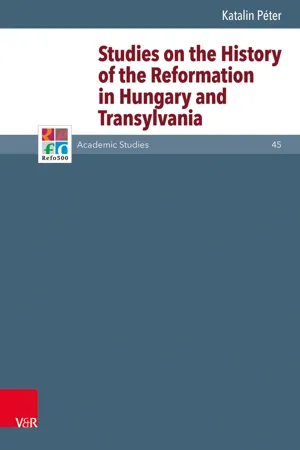
Studies on the History of the Reformation in Hungary and Transylvania
- 216 pages
- English
- PDF
- Available on iOS & Android
Studies on the History of the Reformation in Hungary and Transylvania
About this book
Katalin Peter offers is a vigorous and stimulating reassessment of the history of the Protestant Reformation in Hungary. The Reformation has traditionally been explained in terms of theology, the corruption of the church, and the roles of princes. Katalin Peter shifts the context of study of the Reformation in Hungary to a bottom-up examination of the social dynamics of religious change, producing a lively narrative of the experiences and reactions of contemporary actors - including rural town and village communities, local priests and landlords - to evangelical ideas. Through a close reading of church visitation records, common men and women emerge on the pages of the book both as the agents of religious change and as the defenders of the old faith, while local priests, as Peter, had to adapt to lay demands. A comparative analysis of the position and actions of landlords as church patrons in all three parts of contemporary Hungary – the kingdom under Habsburg rule, the Ottoman-vassal Principality of Transylvania, nd Ottoman Hungary – leads to the conclusion that patrons did not interfere in local religious change, since this change did not interfere with the distribution of power. In addition to this radically new narrative of the social dynamics of the early Reformation in Hungary, Peter engages in the long-standing debates concerning the roles of the Protestant Reformation in intellectual culture, and she illuminates the scopes and limits of the confessional cultures that emerged in its wake. The book brings together a coherent body of work that began to be published in the 1990s and until now has only been available in Hungarian.
Frequently asked questions
- Essential is ideal for learners and professionals who enjoy exploring a wide range of subjects. Access the Essential Library with 800,000+ trusted titles and best-sellers across business, personal growth, and the humanities. Includes unlimited reading time and Standard Read Aloud voice.
- Complete: Perfect for advanced learners and researchers needing full, unrestricted access. Unlock 1.4M+ books across hundreds of subjects, including academic and specialized titles. The Complete Plan also includes advanced features like Premium Read Aloud and Research Assistant.
Please note we cannot support devices running on iOS 13 and Android 7 or earlier. Learn more about using the app.
Information
Table of contents
- Title Page
- Copyright
- Table of Contents
- Body
- List of Illustrations
- List of Abbreviations
- Preface
- Foreword
- Part I Coercion or Choice? The Early Reformation in Hungary
- An Opening Word
- 1 Introduction: Art Treasures and Historiography
- 2 The Coexistence of Languages and Churches
- 3 Some Facts about Domination
- 4 Peasant Rebellion in 1514
- 5 The Beginnings of the Reformation
- 6 Patrons in the Reformation
- 7 Conclusion: What Did the Reformation Mean for the Communities?
- Bibliography
- Part II Confessional Cultures and Beyond
- 1 The Apocalyptic Mood in Sixteenth-Century Hungary
- 2 Confessionally Undivided Hungary After the Reformation
- 3 Golden Age and Decay in Intellectual Culture at the Turn of the Seventeenth Century
- 4 Hungarian Schooling in Transylvania in the Sixteenth and Seventeenth Centuries
- 5 Actions and Ideas: Religious Resistance in the Four Congregations of the Fraknó Manor in 1638
- Subject Index
- Index of Places
- Index of Persons